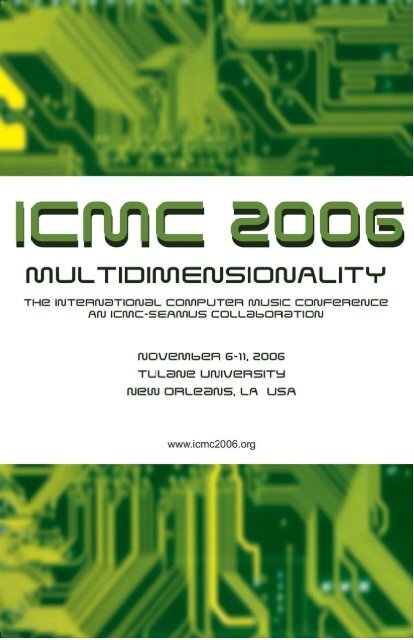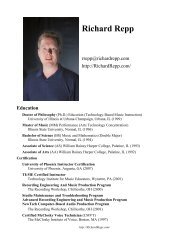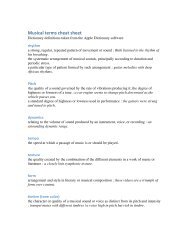Recording Quality Ratings by Music Professionals - Richard Repp
Recording Quality Ratings by Music Professionals - Richard Repp
Recording Quality Ratings by Music Professionals - Richard Repp
Create successful ePaper yourself
Turn your PDF publications into a flip-book with our unique Google optimized e-Paper software.
4:30 PM Real-Time Synchronization of Independently-<br />
Controlled Phasors<br />
Lonce Wyse<br />
5:00 PM A Paradigm For Physical Interaction With Sound<br />
In 3-D Audio Space<br />
Mike Wozniewski, Zack Settel, Jeremy Cooperstock<br />
5:30 PM Jam'aa - A Middle Eastern Percussion Ensemble<br />
for Human and Robotic Players<br />
Gil Weinberg, Scott Driscoll, Travis Thatcher<br />
Paper Session 8 B<br />
Diboll Conference Center Room B<br />
<strong>Music</strong> Analysis<br />
3:30 PM <strong>Recording</strong> <strong>Quality</strong> <strong>Ratings</strong> <strong>by</strong> <strong>Music</strong> <strong>Professionals</strong><br />
<strong>Richard</strong> <strong>Repp</strong><br />
4:00 PM Data Association Techniques for a Robust Partial<br />
Tracker of <strong>Music</strong> Signals<br />
Hamid Satar-Boroujeni, Bahram Shafai, Patric J. Wolfe<br />
4:30 PM <strong>Music</strong>al Tension Curves and Its Applications<br />
Min-Joon Woo, In-Kwon Lee<br />
5:00 PM Detecting Motives and Recurring Patterns in<br />
Polyphonic <strong>Music</strong><br />
Paul Utgoff, Phillip Kirlin<br />
5:30 PM Melodic Modeling: A Comparison of<br />
Scale Degree and Interval<br />
Yipeng Li, David Huron<br />
136
<strong>Recording</strong> <strong>Quality</strong> <strong>Ratings</strong> <strong>by</strong> <strong>Music</strong> <strong>Professionals</strong><br />
<strong>Richard</strong> <strong>Repp</strong>, Ph.D.<br />
Department of <strong>Music</strong>, Georgia Southern University<br />
rrepp@richardrepp.com<br />
Abstract<br />
This study explored whether music professionals<br />
can perceive quality differences in recordings of<br />
classical musicians on acoustic instruments.<br />
Thirty-two music professionals listened to a<br />
series of twelve recordings at nine differing<br />
quality levels. <strong>Quality</strong> levels included pristine 24<br />
bit, 192 kHz recordings, Compact Disk (CD)<br />
quality recordings, cassette tapes, MP3 files, and<br />
recordings with noise added. The participants<br />
judged the quality of the recordings. A one-way<br />
ANOVA test found significant differences among<br />
the responses from groups (F=302, p
of sufficient quality to provide an accurate<br />
picture of your work.” Wittenberg College.<br />
“If you cannot arrange an in-person<br />
audition, you may submit a high quality<br />
audio cassette or CD recording.”<br />
Northwestern University.<br />
“In addition to the video audition you are<br />
welcome to send additional material—CD,<br />
cassette or video of live performances,<br />
studio or home recordings, lyric sheets,<br />
bios or reviews.” University of Otago.<br />
“You can audition in person … or you can<br />
send a CD, tape or even video. Make this<br />
as high quality as possible.” St. Francis<br />
Xavier University.<br />
“Applicants from outside the United States<br />
may send a CD of the required audition<br />
materials. Any evidence of tampering of<br />
the recording will disqualify the applicant.”<br />
Civic Orchestra of Chicago.<br />
Many of the audition announcements mention<br />
the importance of high quality recordings, but<br />
none specifically define what an acceptable level<br />
of quality is.<br />
2 Research Literature<br />
Although research directly applicable to<br />
music auditions is extremely limited, a wealth of<br />
information on the recording process exists.<br />
Most applicable to the present research include<br />
those studies on the recording environment<br />
(McKinnie, 1991; 1996; Møller, Sørensen,<br />
Jensen, & Hammershøi, 1996; Newell &<br />
Holland, 1997). These studies stress the<br />
importance of a controlled listening environment<br />
and its relationship to the perception of music.<br />
Applicable research on the recording process<br />
also includes Gabrielsson, Hagreman, Bech-<br />
Kristensen, and Lundberg (1990) and Lipshitz<br />
(1986). Some research directly addresses the<br />
issue of whether the high-frequency possibilities<br />
of high-sampling rate recordings actually<br />
improves sound quality (e.g., Ohashi, Nishina,<br />
Kawai, Fuwamoto, & Imai, 1991; Ohashi,<br />
Nishina, Fuwamoto, and Kawai, 1993; Zielinski<br />
S.K., Rumsey, & Bech, 2002).<br />
For purposes of designing testing<br />
mechanisms, several evaluation scenarios were<br />
explored (Bareham, 1996; Bech, 1987; Hansen<br />
& Munch, 1991, Meilgaard, Civille, & Carr,<br />
1991), with an emphasis on those systems that<br />
test subjective reactions to recordings rather than<br />
technical readings (Grewin, 1995; Guski, 1997;<br />
Precoda, & Meng, 1997; Stuart, 1991; Toole,<br />
1985). More general work includes studies on<br />
perception (Bregman, 1990; International<br />
Telecommunications Union, 1997; Griesinger,<br />
1997; 2001; Mason & Rumsey, 2000; Terhardt,<br />
1990; Umemoto, 1990; Rumsey, 1999) and<br />
subjectivity (Berg & Rumsey, 2000; Kirk, 1956;<br />
Kosslyn, 1981; Meares, 1993; Moore, 1997).<br />
Applicable research on acoustics is plentiful<br />
(e.g., Ando, 1998; Blauert & Lindemann, 1986;<br />
Mapp, 1997).<br />
Some research exists on the relationship<br />
between quality of recordings and enjoyment of<br />
music. Research indicates that the cost of an<br />
audio system does not have a statistical<br />
correlation to appreciation of the art. Roy Harris<br />
(2002) writes,<br />
Currently, there is no evidence that music<br />
appreciation is dependent on sound quality.<br />
This means that one can attain the same<br />
level of musical enjoyment from any<br />
medium as long as the flaws in the<br />
components do not render the sound<br />
unpalatable. The reason one enjoys the<br />
music when listening uncritically has little<br />
to do with the quality of one's stereo<br />
system, as the sound quality is not a<br />
predictor of the affect music has on a<br />
listener.<br />
Mark Sauer (2000) also found that<br />
“…greater accuracy does not mean more<br />
pleasure. If the sound quality of stereo systems is<br />
not a significant contributor to a satisfactory<br />
listening experience, what is? The answer may<br />
reside within the listener.”<br />
However, little hard research exists on the<br />
correlation between quality of recorded audio<br />
and perception of the performer in an audition<br />
situation. In fact, most of the research in the area<br />
of auditioning is not experimental, and is more<br />
experiential (e.g., Legge, 1990). In a professional<br />
environment the listener is less interested in the<br />
enjoyment of music, as stressed in the research,<br />
and more interested in the skills of the applicant.<br />
3 Methodology<br />
Research Question: Are recording quality<br />
differences noticeable to music professionals?<br />
Auditioners are interested in whether a<br />
high-quality recording affects their score on<br />
auditions. But in order to answer this question,<br />
first the level at which potential audition judges<br />
can notice quality differences takes precedence.
3.1 Participant Selection<br />
After obtaining permission from an<br />
Institutional Review Board, participants (N=32)<br />
gave permission to take art in the experiment. All<br />
experimental participants were music<br />
professionals, mostly university professors. Five<br />
of the participants were graduate students who<br />
had worked in the past as music professionals.<br />
Participants were not selected randomly from a<br />
larger population group. Participant selection<br />
emphasized real-world experience in auditions so<br />
that the results could be generalized to the<br />
population of music professionals likely to hear<br />
audition recordings.<br />
3.2 Procedures<br />
The experimenters produced recordings of<br />
four different instruments—French horn, flute,<br />
clarinet, and voice—with three recordings each,<br />
for a total 12 separate recordings. All selections<br />
were recorded dry (with no reverberation, natural<br />
or artificial), with no accompaniment.<br />
All recordings took place in the same room<br />
with the same equipment and setup.<br />
Two Neumann KM-184s in a stereo<br />
configuration recorded through a Mark of the<br />
Unicorn (MOTU) 896 analog to digital converter<br />
(ADC) into MOTU Digital Performer software.<br />
The original bit rate and sample rate of the<br />
recordings was at 24 bit, 192 kHz (defined here<br />
as very high quality). Normalized recordings<br />
(amplified to maximum possible level) assured<br />
that judgments were not affected <strong>by</strong> volume<br />
differences.<br />
Then, data reduction procedures reduced the<br />
quality of each of the recordings eight times, for<br />
a total of 9 data groups. The original recordings<br />
of 24 bit, 192 kHz went through a translation to<br />
16 bit 44.1 kHz (standard CD quality). A third<br />
group was in the popular MP3 format at the<br />
standard 128 kbps data rate. The third group<br />
represented medium fidelity in today’s digital<br />
world. The fourth data group consisted of the<br />
original examples recorded to cassette tape.<br />
Additional groups included the original<br />
recording mixed with differing levels of pink<br />
noise. The reference value for mixing of pink<br />
noise would be from a level of “0” having equal<br />
amounts of pink noise as the original signal; the<br />
next highest quality signal (presumably) was –60<br />
dB pink noise (60 dB softer than equal amounts).<br />
Then groups of –50 dB, -40 dB, -30 dB, and –15<br />
dB added pink noise completed the nine groups.<br />
The total number of samples, 12 recordings<br />
at nine quality levels for a total of 108 examples,<br />
was too large, so a stratified sample provided a<br />
final grouping. Three examples of each of the<br />
original recordings were chosen at three different<br />
levels, so that each of the nine quality groups had<br />
four samples, for a total of 36 items in the final<br />
data list. All musical examples, quality<br />
examples, and instrument groups had an equal<br />
number of items in the final set. The final set<br />
contained the 36 examples put into a random<br />
order using a software-driven randomizer.<br />
3.3 Data Collection<br />
The participants listened to the examples in<br />
a quiet (less than 30 dB SPL ambient noise),<br />
acoustically balanced room. Monitors (speakers)<br />
consisted of Tannoy Reveal Monitors placed one<br />
meter from the subject at the corners of an<br />
imaginary equilateral triangle. All participants<br />
sat in the same chair, which was in the same<br />
position (the third corner of the triangle), for<br />
every session. Before the session began, the<br />
experiments tested the audio to confirm that the<br />
volume levels were consistent (~78 dB SPL)<br />
using and SPL meter.<br />
Before the experiment, a recorded voice<br />
reminded the participants that they were judging<br />
the quality of the recording, and not the<br />
performance of the person recorded. The<br />
participants rated the recording quality on a ten<br />
point Likert-type scale, with 10 being the best<br />
possible recording. Testers did not coach the<br />
participants as to what “good” or “bad” quality<br />
was. If the participants asked questions<br />
concerning the definition of quality before the<br />
experiment began, they were told to use their<br />
best judgment.<br />
3.4 Results<br />
Figure 1 shows the relative scores for the<br />
means each of the quality comparison groups<br />
with their 95% confidence interval.
Figure 1. Error Plot of Relative Means of Scores<br />
for <strong>Quality</strong> Groups (95% CI).<br />
Figure 4. Tukey HSD Homogenous<br />
Groups.<br />
The following graph (Figure 5) shows a<br />
graphical representation of the data in Figure 4,<br />
with homogeneous subsets connected <strong>by</strong> shaded<br />
areas over the error plots from Figure 1.<br />
Figure 5. Homogeneous Groups Graph.<br />
A One-way ANOVA test using SPSS<br />
software showed that there is significant<br />
differences among the groups at p
voice) show that on three of the four subgroups,<br />
the 16 bit 44.1 kHz example actually scored<br />
slightly higher than the 24 bit, 192 kHz example.<br />
(See Figures 6-9.)<br />
Figure 9. Relative Means for Horn Examples.<br />
Figure 6. Relative Means for Clarinet Examples.<br />
Figure 7. Relative Means for Flute Examples.<br />
Figure 8. Relative Means for Vocal Examples.<br />
Only the large difference in the horn<br />
example (Figure 9) accounts for the final<br />
difference.<br />
A clear distinction exists between the high<br />
fidelity group and the next homogeneous group,<br />
which consists of the MP3 sample, cassette tape<br />
recordings, and the recording with –60 dB pink<br />
noise added (see Figure 5). <strong>Music</strong> professions<br />
were clearly able to hear the difference between<br />
a CD quality recording and a cassette quality<br />
recording or its equivalent.<br />
One might expect an MP3 recording to<br />
sound better than a cassette tape. The lack of<br />
difference in these scores could be influenced <strong>by</strong><br />
several factors. The cassette recordings used in<br />
this experiment were of unusually high quality,<br />
since they were recordings from a digital source<br />
that had been recorded under optimal conditions.<br />
The cassettes one might expect to hear in a realworld<br />
audition would probably be recorded<br />
directly to tape, and presumably would not be as<br />
high a quality, even if the same recording setting<br />
existed.<br />
The wide variation in possible MP3 qualities<br />
could also be a factor. A well-engineered MP3<br />
file is not distinguishable from a CD quality<br />
recording. The MP3 files in this experiment were<br />
purposely of low quality. Interestingly, the<br />
digital artifacts in the MP3 files (jitter) were no<br />
more or less distracting to the participants than<br />
the inherent noise associated with cassette tape<br />
recording.<br />
Readings on the low quality recordings<br />
(pink noise added) are less interesting from a<br />
real-world perspective because recordings as bad<br />
as the worst recordings would never be used in<br />
an audition situation. The poor examples were<br />
useful in dispersing the Likert-type responses, so<br />
that the participants could hear what a truly very<br />
bad recording sounds like. The data also shows<br />
that the participants were able to distinguish a 10<br />
dB addition of pink noise.
5 Conclusions<br />
<strong>Music</strong> professionals are able to hear the<br />
difference between a compact disk quality<br />
recording and the same recording transferred to<br />
cassette tape. For this reason, the researcher<br />
recommends using a digital CD recording for<br />
audition purposes rather than a cassette copy.<br />
<strong>Music</strong> professionals do have a discerning ear for<br />
recordings, even though they may have been<br />
raised on old, scratched records and hiss-filled<br />
tape. However, extremely high quality<br />
recordings above standard CD quality are ranked<br />
equivalent to CDs <strong>by</strong> music professionals, so<br />
spending the extra money for these recordings is<br />
not necessary.<br />
Also, if the music professionals judge the<br />
recording quality of 128 kbps MP3 files and<br />
cassette tapes equivalent (as shown <strong>by</strong> this<br />
study), this does not mean that this difference in<br />
medium will not affect their judgment. The<br />
impact on the judgment of the visual quality of<br />
the material could also be considered as well as<br />
the use of "up-to-date technology". A<br />
professional-looking CD-ROM with MP3 files<br />
might make a better impression on the judges<br />
than an old cassette tape. This should not matter<br />
to judge the quality of a performer, but it<br />
probably does matter in reality.<br />
Even though this study has proven that<br />
musicians can hear these differences, the<br />
question still remains as to whether these<br />
differences in recording quality lead to improved<br />
scores on auditions. Now that the researcher has<br />
proven that these differences exist, future studies<br />
must prove whether judges ignore the<br />
differences, either consciously or unconsciously.<br />
Another possibility may be that a poor recording<br />
masks flaws in the performance, so that a highquality<br />
recording actually hurts the audition<br />
score.<br />
Another question left unanswered is whether<br />
music professionals would be able to hear the<br />
recording quality differences outside of a<br />
controlled listening environment. In order to<br />
achieve statistical certitude in an experimental<br />
setting, experimenters are forced to limit<br />
extraneous causes of error, such as differences in<br />
playback equipment for the judges. These<br />
differences could muddy the listening capacity of<br />
musical professionals, and skew the results of<br />
this study.<br />
Factors other than bit rate, sampling rate,<br />
and the amount of noise in a recording also affect<br />
the quality of the recording. The hall in which<br />
the recording takes place, ambient noise in the<br />
hall, microphone placement, audience noise, and<br />
many other factors all contribute to a successful<br />
recording. Although the interplay of these factors<br />
is out of the scope of this particular project, the<br />
study still proves that musicians can hear quality<br />
differences. With the extreme level of<br />
competition in audition situations, one would<br />
surmise that a performer would want every<br />
advantage possible, and a high-fidelity CD<br />
recording provides such an advantage.<br />
References<br />
Ando, Y. (1998). Architectural Acoustics:<br />
Blending Sound Sources, Sound Fields, and<br />
Listeners. New York: Springer-Verlag.<br />
Bareham, J. R. (1996). Measurement of spatial<br />
characteristics of sound reproduced<br />
in listening spaces. Audio Engineering Society<br />
Preprint, 101st Convention, preprint no. 4381.<br />
Bech, S. (1987). Planning of listening tests –<br />
choice of rating scale and test procedure, in<br />
Bech, S. and Pedersen O. J., eds. Proceedings<br />
of a Symposium on Perception of Reproduced<br />
Sound. Denmark: Stougaard Jensen. 61-70.<br />
Berg, J. & Rumsey F. (2000). Correlation between<br />
emotive, descriptive and naturalness attributes<br />
in subjective data relating to spatial sound<br />
reproduction. Audio Engineering Society<br />
Preprint, 109th Convention, preprint no. 5206.<br />
Blauert, J. & Lindemann, W. (1986). Auditory<br />
spaciousness: some further psychoacoustic<br />
analyses. Journal of the Acoustical Society of<br />
America, vol. 80, (2). 533-542.<br />
Bregman, A. S. (1990). Auditory Scene Analysis:<br />
The Perceptual Organization of Sound.<br />
Cambridge, USA: MIT Press.<br />
Gabrielsson, A., Hagreman, B., Bech-Kristensen,<br />
T. & Lundberg, G. (1990). Perceived sound<br />
quality of reproductions with different<br />
frequency responses and sound level, Journal of<br />
the Acoustical Society of America, 88, 1359-<br />
1366.<br />
Grewin, C. (1995). Can objective measures replace<br />
subjective assessments? Audio Engineering<br />
Society Preprints, 99th Convention, preprint no.<br />
4067.<br />
Griesinger, D. (1997). The psychoacoustics of<br />
apparent source width, spaciousness and<br />
envelopment in performance spaces. Acoustica,<br />
83 (4). 721-731.<br />
Griesinger, D. (2001). The psychoacoustics of<br />
listening area, depth, and envelopment in<br />
surround recordings, and their relationship to<br />
microphone technique. Proceedings of the 16th
International Audio Engineering Society<br />
Conference, Bavaria, Germany, 182- 200.<br />
Guski, R. (1997). Psychological methods for<br />
evaluating sound quality and assessing acoustic<br />
information. Acta Acustica, 83. 765-774.<br />
Hansen, V. & Munch, G. (1991). Making<br />
recordings for simulation tests in the<br />
Archimedes project. Journal of the Audio<br />
Engineering Society, 39 (10). 768-774.<br />
Harris, R. (2002). Audiophilia, November 2002.<br />
International Telecommunications Union, (1997).<br />
Methods for the subjective assessment of small<br />
impairments in audio systems including<br />
multichannel sound systems. International<br />
Telecommunications Union -<br />
Radiocommunications, Recommendation ITU-<br />
R BS 1116.<br />
Kirk, R. E. (1956). Learning, a major factor<br />
influencing preferences for high-fidelity<br />
reproducing systems. Journal of the Acoustical<br />
Society of America, vol. 28 (6). 1113-1116.<br />
Kosslyn, S. M. (1981). The medium and the<br />
message in mental imagery: a theory,<br />
Psychological Review, 88 (1), 46-66.<br />
Legge, A. (1990). The Art of Auditioning. London:<br />
Rhinegold.<br />
Lipshitz, S. (1986). Stereo microphone techniques:<br />
are the purists wrong? Journal of the Audio<br />
Engineering Society, 34, (9). 716-744.<br />
Mason, R. and Rumsey, F. (2000). An assessment<br />
of the spatial performance of virtual home<br />
theatre algorithms <strong>by</strong> subjective and objective<br />
methods. Audio Engineering Society, 108th<br />
AES Convention, preprint 5137.<br />
Mapp, P. (1997). “Effects of Equalization on<br />
Sound System Intelligibility and Perceived<br />
Performance.” 103rd AES Convention. New<br />
York.<br />
McKinnie, D, (1996). Objective Selection of<br />
Critical Material for Subjective Testing of Low<br />
Bit-rate AudioCoding Systems. Master's Thesis,<br />
McGill University, Montreal.<br />
McKinnie, D, (1991). <strong>Recording</strong> Techniques and<br />
the Perception of Environment, Audio<br />
Engineering Society Preprint, 91st AES<br />
Convention. Preprint No. 3110.<br />
Meares, D. J. (1993). Perceptual Attributes of<br />
Multichannel Sound. Proceedings of AES 12th<br />
International Conference 'The Perception of<br />
Reproduced Sound', 171-179.<br />
Meilgaard, M., Civille, G. V. and Carr, B. T.<br />
(1991). Sensory Evaluation Techniques, 2nd<br />
edition, Boca Raton, FL: CRC Press.<br />
Møller, H., Sørensen, M. F., Jensen, C. B. and<br />
Hammershøi, D. (1996).<br />
Binaural technique: Do we need individual<br />
recordings? Journal of the Audio Engineering<br />
Society, 44, 451-469.<br />
Moore, B. C. J. (1997). An Introduction to the<br />
Psychology of Hearing, 4th edition.<br />
London: Academic Press,.<br />
Newell, P. R. & Holland, K. R. (1997). “A<br />
Proposal for a More Perceptually Uniform<br />
Control Room for Stereophonic <strong>Music</strong><br />
<strong>Recording</strong> Studios.” 103rd AES Convention.<br />
New York.<br />
Ohashi, T., Nishina, E., Kawai, N., Fuwamoto, Y.,<br />
& Imai, H., (1991). High Frequency Sound<br />
Above the Audible Range Affects Brain<br />
Electrical Activity and Sound Perception, AES<br />
91st Convention, New York, preprint 3207.<br />
Ohashi, T., Nishina, E., Fuwamoto, Y., & Kawai,<br />
N., (1993). On the Mechanism of Hypersonic<br />
Effect. Proceedings Int'l Computer <strong>Music</strong><br />
Conference, Tokyo, 432–434.<br />
Precoda, K. Meng, K. (1997). “Subjective Audio<br />
Testing Methodology and Human Performance<br />
Factors” 103rd AES Convention. New York.<br />
Rumsey, F. (1998). Subjective assessment of the<br />
spatial attributes of reproduced sound.<br />
Proceedings of the 15th International Audio<br />
Engineering Society Conference, Copenhagen,<br />
Denmark, 122-135.<br />
Rumsey, F. (1999). Controlled subjective<br />
assessments of two-to-five-channel surround<br />
sound processing algorithms. Journal of the<br />
Audio Engineering Society, 47 (7/8). 563-582.<br />
Sauer, M. (2000). Stereophile, 1, 57.<br />
Schroeder, M. R. (1993). Listening with Two Ears.<br />
<strong>Music</strong> Perception, 10 (3), 255–280.<br />
Stuart, J.R. (1994). “Perceptual issues in<br />
multichannel environments” 97th AES<br />
Convention, San Francisco.<br />
Stuart, J.R. (1991). Psychoacoustic models for<br />
evaluating errors in audio systems. PIA, 13 (7),<br />
11–33.<br />
Toole, F. (1985). Subjective measurements of<br />
loudspeaker sound quality and listener<br />
performance, Journal of the Audio Engineering<br />
Society 33, (1/2). 2-32.<br />
Terhardt, E., (1990). <strong>Music</strong> perception and sensory<br />
information acquisition: relationships and lowlevel<br />
analogies. <strong>Music</strong> Perception, 8 (3), 217-<br />
239.<br />
Umemoto, T. (1990). The Psychological Structure<br />
of <strong>Music</strong>. Perception, 8 (2), 115–128.<br />
Zielinski S. K., Rumsey F., & Bech S. (2002).<br />
Subjective audio quality trade-offs in consumer<br />
multichannel audio-visual delivery systems.<br />
Part I: Effects of high frequency limitation.<br />
AES 112th Convention, Paper 5562.








